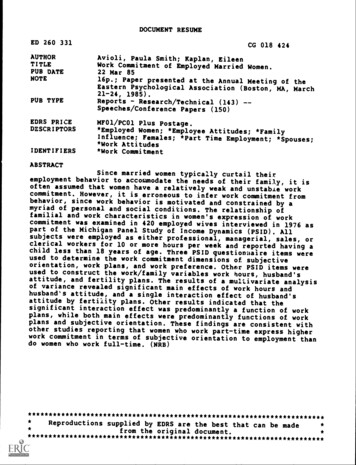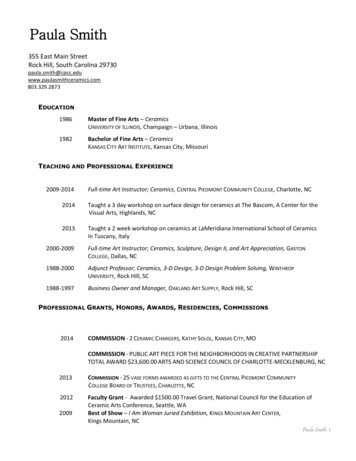
Transcription
DOCUMENT RESUMEED 260 331AUTHORTITLEPUB DATENOTEPUB TYPEEDRS PRICEDESCRIPTORSIDENTIFIERSCG 018 424Avioli, Paula Smith; Kaplan, EileenWork Commitment of Employed Married Women.22 Mar 8516p.; Paper presented at the Annual Meeting of theEastern Psychological Association (Boston, MA, March21-24, 1985).ReportsResearch/Technical (143) -Speeches /Conference Papers (150)MF01/PC01 Plus Postage.*Employed Women; *Employee Attitudes; *FamilyInfluence; Females; *Part Time Employment; *Spouses;*Work Attitudes*Work CommitmentABSTRACTSince married women typically curtail theiremployment behavior to accommodate the needs of their family, it isoften assumed that women have a relatively weak and unstable workcommitment. However, it is erroneous to infer work commitment frombehavior, since work behavior is motivated and constrained by amyriad of personal and social conditions. The relationship offamilial and work characteristics in women's expression of workcommitment was examined in 420 employed wives interviewed in 1976 aspart of the Michigan Panel Study of Income Dynamics (PSID). Allsubjects were employed as either professional, managerial, sales, orclerical workers for 10 or more hours per week and reported having achild less than 18 years of age. Three PSID questionaaire items wereused to determine the work commitment dimensions of subjectiveorientation, work plans, and work preference. Other PSID items wereused to construct the work/family variables work hours, husband'sattitude, and fertility plans. The results of a multivariate analysisof variance revealed significant main effects of work hours andhusband's attitude, and a single interaction effect of husband'sattitude by fertility plans. Other results indicated that thesignificant interaction effect was predominantly a function of workplans, while both main effects were predominantly functions of workplans and subjective orientation. These findings are consistent withother studies reporting that women who work part-time express higherwork commitment in terms of subjective orientation to employment thando women who work full-time. **************************Reproductions supplied by EDRS are the best that can be madefrom the original ******************************
1WORK COMMITMENT OF EMPLOYED MARRIED WOMENbyPaula Smith AvioliKean College of New JerseyandEileen. KaplanMontclair State College(NICOOPaper presented at the 1985 meeting of the Eastern Psychological Association,March 22, 1985 in Boston, Massachusetts.simanumn Of INDUCATIONNATIONAL INSTITUTE Of EDUCATIONEDUCATIONAL RESOURCES INFORMATIONCENTER CENCIX Th4 dommortt has Soon noteixad asmowed from We Wm, NI"PERMISSION TO REPRODUCE THISM5TERIAL HAS BEEN GRANTED. BYjoneoeireCiMew chanson have Won mph le wore.*eloproduchonfctinis of tin. w opiniers NNW in this yeumentnot roeseastiy nromors Oficial NWpomin a PsEcy.TO THE EDUCATIONAL RESOURCESINFORMATION CENTER (ERIC).-
In this paper, we present a conceptualization of the work commitmentconstruct and examine the relationship of familial and work characteristicsin women's expression of work commitment using data from the Michigan PanelStudy of Income Dynamics.Since married women typically curtail theiremployment behavior to accommodate the needs of their family, it is oftenassumed that women have relatively weak and unstable work commitment.However, it is erroneous to infer work commitment from behavior as work behavioris motivated and constrained by a myriad of personal and social conditions.Currently, there exists great variability in both the conceptualizationand operationalitation of the work commitment construct.In a recent reviewof this problem, Mbrrow (1983) pointed out that there is considerable conceptual redundancy between such terms as work commitment, career salience andjob involvement.Whereas career salience typically denotes the relativeimportance of work and a career in one's total life, and job involvementusually refers to the absorptiveness of work or one's psychological identification with one's job, our focus in this paper is the intrinsic value of workes an end in itself.That is, whether work is viewed as an interestingactivity apart from extrinsic considerations.Such a conceptualization isfrequently used in organizational behavior literature.Work commitment has been traditionally operationalized either in terms ofwork plans, work preferences, or expectations and aspirations regarding workbehavior.We propose that any individual item has limited utility.Ratherthe work commitment construct needs to be conceptualized in terms of multipleindicators which tap the saliency of employment for the individual as well asher plans and preferences for work behavior.We operationalized work commitment using three items.The first welabelled "subjective orientation" and is measured by the question; "If you were
2to get enough money to live as comfortably as you would like for the restof your life, would you continue to work?" This is a traditional measureof the intrinsic value of employment and has been used in a number of studies(Haller & Rosenmayer, 1971; Orden & Bradburn, 1969; Angrist & Almquist, 1970).Our item, "work preference" similarly tape the intrinsic value ofemployment apart from financial considerations, but is posed in terms of thenumber of hours one works.Our third item, "work plans" is intended tomeasure the woman's attitude toward continued labor force participation.As married women's labor force participation is usually optional, thismeasure is thought to capture more of the woman's tastes for market work thanwould be true for other populations (Dowdall, 1974).All items are scoredso that a higher score indicates higher work commitment.Additional indicatorswould be desireable to capture the subtle differences in which work commitmentmay be expressed but for the present study, the questions which could be askedare limited by the data.Since work commitment is likely to vary as a function of social conditions,our approach is to examine married women's work commitment in the context inwhich it is expressed.As women have been traditionally socialized to deriveintrinsic satisfaction from their wife- mother duties, some theorists (Waite,1980; Thomson, 1980; Kupineky, 1977) contend that female work commitmentreflects a tradeoff of work and familial activities.The economists cast thistradeoff relationship in terms of the opportunity costs of family and employment.As employment curtails the woman's available time for her wife-motheractivities, opportunity costs of employment include further childbearing andtime for marital companionship.Conversely, the reduction of work hours isan opportunity coat of the family.Another way to conceptualize this trade-off relationship is the woman's assessment of job-family conflict, that is,how well she coordinates job and family responsibilities.For married women,
3Ithe perception of job-family mallet is highly dependent on their husbands!,attitude toward their employment (Holahan & Gilbert, 1979; Avioli, in press).Slide 2 shows the measures we used to tap these trade-off costa.Workhours is a dichotomised variable split into full-time and part -time categories.Husband's attitude is the wife's perception of her husband's attitude towardthe wife's employment.Fertility plans refers to the woman's intention forfurther childbearing constructed from two items from the PSID questionnaire.It was hypothesized that women would express higher work commitment whenemployment was perceived as compatible with their familial activities.Thatis, the sense of work as an intrinsically valued activity is likely to beenhanced when the opportunity costs of employment are low.SubjectsThe sample consists of 420 employed wives interviewed in the 1976 waveof the PSID project (the only year to date that wives have been interviewed).Subjects were employed as either professional, managerial, sales or clericalworkers for 10 or more hours per week and reported having a child less than18 years of age.ResultsA complete design fixed-effects ?4ANOVA was performed.As can be seenin Table 2, MANOVA results revealed significant main effects of work hoursand husband's attitude, and a single significant interaction effect ofhusband's attitude by fertility plans.As trends of increase in a MANOVAmay differ among the dependent variables, the univariate analyses and itemmean values were also examined.(Tatauoke,1971).The significant interaction effect is predominantly a function of workplans.Women tend to plan on staying in the workforce when opportunity costs
of employment are low.That is, their husbands strongly favor their workingand wives do not plan to have more children.The main effect of husband's attitude is also predominantly a functionof work plans, however subjective orientation also load. in the same direction.Women are more likely to plan on staying in the workforce and to work withoutfinancial motivation when their husbands are highly in favor of their employment.The significant main effect of work hours is the most interesting finding.Once again the effect is predominantly a function of work plane and subjectiveorientation.However, as can be seen in the next slide, the trends of increaseare contrary for the two items. When the opportunity cost for the family ishigh. that is, when women work full-time, they are more likely to plan onstaying in the workforce.Whereas, when the opportunity cost for thefamily is low; when women work part-time and so they have more availabletime for familial activities, they are more likely to report that they wouldwork without financial need.ImplicationsThe results confirm the importance of conceptualizing female work commitment in terms of multiple indicators as married women's plans, preferences andsubjective orientation toward employment are differentially related to characteristics of their familial and work activities.not isomorphic with work behavior.Clearly, work commitment isOur findings are consistent with severalrecent studies ( Bielby & Bielby, 1984; Moen & Smith, 1965; Thomson, 1980)indicating that part-time working women express higher work commitment interms of subjective orientation to employment as compared to full-time workingwomen.Many wooer, may be committed to work, but elect to work part-time ratherthan full-time as it is easier to coordinate employment and family life,
5particularly when children are young.However, what may appear to be anoptimal trade-off in the short-run may be dysfunction to women's careerdevelopment in the long run.By using mu-tiple indicators of the work commitment construct, we hazebeen able to demonstrate the differential expression of work commitment ofpart-time and full-time working women.Ideally, full-time jobs whichoffer greater schedule flexibility, provisions for child care and othersupports would combine the advantages of both part-time and full-time potations,promoting women's career development, as well as their work commitment.FUture research might well explore whether electing part-time employmentconstrains later career advancement and earnings, and whether this would bemore true for some occupations than others.We are currently planning afollow-up longitudinal' analysis to determine whether work commitment andchanges in family life cycle stage predict subsequent employment behavior.
6REFERENCESAngrist, S. S., & Almquist, E. M. (1975).college women N& l. with gender.Avioli, P. S. (in press).of infants.New York:HowDunellen.The labor force participation of married mothersJournal of Marriage and the Family.Bielby, D. D., & Bielby, W. T. (198k).and women's employment.Dowdall, J. A. (197k).Work commitment, sex Tole attitudes,American Sociological Review, ill 23k -2k7.Structural and attitudinal factors associated withfemale labor force participation.Haller, M., & Rosenmayer, L. (1971).commitment.Careers and contingencies:Social Science Quarterly, 2, 121-130.The pluridimensionality of workHuman Relations, 24, 501-518.Holahan, C. K., & Gilbert, L. A. (1979).Career vs. jobs.Interpole conflict for working women:Journal of Applied Psychology, 64Kupinsky, S. (Ed.), (1977).international research.(1), 86-90.The fertility of working women:New York:Moen, P., & Smith, K. R. (1983).A synthesis ofPraeger.Women's work commitment and labor forceattachment by family life stage.Paper presented at the meeting of theAmerican Sociological Association, Detroit, 1983.Morrow, P. C. (1983).Concept redundancy in organizational research:case of work commitment.Academy of ManagementOrden, S. R., & Bradburn, N. M. (1969).TheReview, 486-500Working wives and marriage happiness.American Journal of Sociology, 21, 392-407.Tatsuoka, M. M. (1971).Thomson, E.(1980).Multivariate analysis.New York:John Wiley & Sons.The value of employment to mothers of young children.Journal of Marriage and the Family, 42, 551-566.Waite, L. J. (1980).Working wives and the family life cycle.Journal of Sociology, 86 (2) 272-294.8American
SLIDEICoding Schemes and PSID Questionnaire ItemsUsed to Determine the Work Commitment ItemsItemQuestionnaire Item(s)ValuesSubjectiveOrientation'If you were to get nough(1) No(2) Don't Know(3) 118money to live as comfortablyas you would lik for the restof your 1117 would youcontinue to work?'Work PlansWork Prfrncd'Do you think you will keep onworking for the next fewyears or do you plan to quit ?'(1) Plan To Quit'Would you have prfrrd to(1) Prefer To Workwork loafs vn if you hadarnd less money ?'(2) Do Not Prfr To(2) Kp On WorkingLess HoursWork Less Hours10
SLIDE 2Coding Schemes and PSID Questionnaire ItemsUsed to Construct the Work/Family VariablesVariableQuestionnaire Item(s)ValuesWork HoursWif* annual work hours inPart TimFull Tim1976. A woman averaging 35or more hours per week isfull time, 10-34 Is part time.Husband's Attitud"How does your husband fIFertility Plansabout your working?"Vry Much In FavorLss Favorable-Do you xpct to have anyPlan To Hav Mormor children ?'Children"How sure are you that youNot Surwill not hav any morchildren?"11Do Not Plan To HavMore Children12
Tapes1Work Commitment Items and Work/Family CharacteristicsWorkHoursbyWorkHoursMultivariate F (p).Husband's Husband'sFertilityWorkHoursbyFertilitySLIDE .91(.016)3.82(.051)0.00(.989)0.30(.744)0. 20(.6b8)(.014)4. (.109)1. 58(.208)O. t F (p)SubjctlyOrlentatIonawork Plans bWork PrIrncCNOTE.(.1 10)PROBABILITY FIGURES ARE IN PARENTHESES, df NOT INCLUDED,(.563)SEE TEXT FOR DETAILS OFWORK / FAMILY CHARACTERISTICS.a"IF YOU WERE TO GET ENOUGH MONEY TO LIVE AS COMFORTABLY AS YOU WOULD LIKE FOR THEREST OF YOUR LIFE, WOULD YOU CONTINUE TO WORK?"CODED VALUES:(1) NO (2) DON'TKNOW (3) YES,b "DO YUU THINK YOU WILL KEEP ON WORKING FOR THE NEXT FEW YEARS OR DO YOU PLAN TOQUIT?"CODED VALUES: (1) PLAN TO QUIT (2) KEEP ON WORKING."WOULD YUU HAVE PREFERRED TO WORK LESS EVEN IF YOU HAD EARNED LESS MONEY?"GLIDED VALUES: (1) PREFER TO WORK LESS HOURS (2) DO NOT PREFER TO WORK LESS HOURS.1:114
Table 2SLIDE 4Mean Values of Work Commitment ItemsHusband'sAttltudHusband'sWorkHoursaSubjctiv OrintationfWork sePlansPrtrnchMor .80NoNoNSNOEL,NOMIGNIEICANT INTERACIION TERMS NOT INCLUDED.DIFFER SIGNIFICANTLY AT p.05.Mor 28Ms EANS WITH DIFFERENT SUBSCRIPTSSEE TEXT FOR DETAILS OF WORK / FAMILY CHARACTERISTICS. PAN TIME, r) 112; FULL TIME, n 286.b LESS FAVORABLE, n 108; MORE FAVORABLE, r1 282.cNO PLANS FOR CHILDREN. il 257; NOT SURE, r1 47. YES PLAN TO HAVE MORE CHILDREN n 94.dINTERACTION CATEGORIES NO/LESS, n 68; NOT SURE/LESS, n 12; YES/LESS, n 28.e NO/MORE, n 182; NOT SURE /MORE, n 35; YES/MORE, n 65."If YOU WERE TO GET ENOUGH MONEY TO LIVE AS COMFORTABLY AS YOU WOULD LIKE FOR THEREST OF YOUR LIFE, WOULD YOU CONTINUE TO WORK?"CODED VALUES (1) NO (2) DON'TKNOW (3) YES.g"DO YOU THINK YOU WILL KELP ON WORKING FOR THE NEXT FEW YEARS OR DO YOU PLAN TOOBIT ?"CODED VALUES: (1) PLAN TO QUIT (2) KEEP ON WORKING.h"WOULD YOU HAVE PREFERRED TO WORK LESS EVEN IF YOU HAD EARNED LESS MONEY?"CODED VALUES: (1) PREFER TO WORK LESS HOURS (2) DO NOT PREFER TO WORK LESS HOURS.16
Eileen. Kaplan. Montclair State College. Paper presented at the 1985 meeting of the Eastern Psychological Association, March 22, 1985 in Boston, Massachusetts. simanumn Of INDUCATION NATIONAL INSTITUTE Of EDUCATION EDUCATIONAL RESOURCES INFORMATION. X CENTER CENCI Th4 dommortt has Soon noteixad as mowed from We Wm, NI oneoeire. Ci. Mew chanson .










